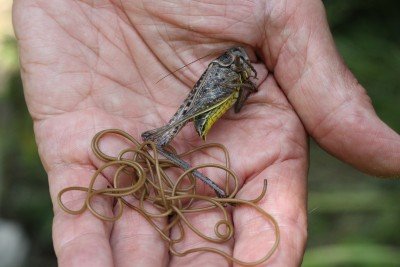
Wolf worms, or *Cuterebra*, are actually parasitic larvae from a type of fly. They’re not your garden-variety pest; these creatures have a unique life cycle and behavior that can affect small mammals like rabbits, squirrels, and more. If you’re curious about what these worms are all about and how they play a role in the ecosystem, you’ve come to the right place. Let’s unpack their effects and see why understanding these insects is important for wildlife health.
What Are Wolf Worms?
Wolf worms are the larvae of bot flies and have a rather surprising life cycle. Adult bot flies lay their eggs in the nests or burrows of small mammals. Once the eggs hatch, the tiny larvae find their way into the host animal’s body, usually through the skin. This might sound a bit like a horror movie, but it’s quite common in the wild. The worm then grows inside the mammal, sometimes even causing visible bumps on their skin.
You might be wondering, “What happens to the small mammals after that?” Well, the larvae live off the nutrients from their host. While they don’t usually kill their hosts outright, they can lead to serious health problems. Think of it as a squatter taking up residence in your home—it’s inconvenient and can lead to a lot of stress!
How Do Wolf Worms Affect Small Mammals Physically?
The physical impact of wolf worms on small mammals can be quite severe. As the larvae grow, they can cause inflammation and discomfort at the site where they’ve entered the host’s body. This often leads to visible lumps, which can become infected if not treated. So, the presence of these worms can make a small mammal more vulnerable to other health issues.
In some cases, if the infestation is severe, the small mammal may exhibit signs of distress such as limping, decreased appetite, or hiding more than usual. The discomfort caused by the larva can lead to behavioral changes, altering how these animals interact with their environment and each other. For instance, a normally active rabbit might become lethargic, making it an easier target for predators.
Behavioral Changes Induced by Wolf Worms
In addition to physical symptoms, wolf worms can cause significant behavioral changes. Small mammals affected by these parasites may retreat from social interactions, becoming isolated and more cautious. Imagine you’re feeling sick—you might prefer to stay home instead of hanging out with friends, right? That’s similar to how these animals might react to the presence of a wolf worm.
Moreover, as the animal’s health declines, their ability to forage for food may diminish. This can create a ripple effect in their habitat, impacting the entire ecosystem. For example, if a crucial prey animal becomes less active, predators may struggle to find food. It’s a delicate balance, and the presence of wolf worms can disrupt it dramatically.
Wolf Worms and Their Impact on Ecosystems
The impact of wolf worms goes beyond just individual mammals. They play a surprising role in the larger ecosystem. When small mammals are affected by these parasites, it can influence predator-prey dynamics. Healthy small mammals usually keep populations of certain predators in check, helping to maintain harmony in the ecosystem.
Increased mortality rates among small mammals can lead to an overpopulation of certain species, which can then affect vegetation and other wildlife. For instance, if rabbits are significantly affected by wolf worms, their numbers may dwindle, allowing plant species that rabbits normally graze on to flourish unchecked. This shows how interconnected everything is; what affects one species can have a domino effect throughout the environment.
Signs of Wolf Worm Infestation in Small Mammals
Being able to spot signs of wolf worm infestation is vital for wildlife caretakers or pet owners. Common indicators include:
- Visible lumps: These can often be seen on the skin, resembling small boils.
- Behavioral changes: Look for lethargy, decreased appetite, or avoidance of social interactions.
- Infection: If the skin where the larvae entered becomes reddish or swollen, that’s a concern.
If you suspect an animal is infested, it’s crucial to consult a veterinarian or wildlife professional. Early intervention can make a big difference in the affected animal’s chances of recovery.
Treatment and Prevention of Wolf Worm Infestations
So, what can be done if a small mammal is infested with wolf worms? Treatment generally involves removing the larvae, which is best done by a professional. Attempting to extract them at home can cause further injury or infection.
Preventing infestations in the first place is ideal. Keeping habitats clean and free of debris can help reduce the chances of adult bot flies laying eggs. Additionally, monitoring small mammals for signs of distress can lead to quicker interventions if a problem arises.
Remember the importance of maintaining healthy environments for these animals. Healthy ecosystems foster resilient wildlife populations, reducing the likelihood of infestations.
The Role of Wolf Worms in Biodiversity
While it might seem strange to appreciate a parasite, wolf worms have a role in maintaining biodiversity. Parasitism, while uncomfortable, is a natural part of life for many species. It can help control populations of small mammals, ensuring they don’t overpopulate an area. In this way, wolf worms contribute to the balance of nature, which is crucial for the health of ecosystems.
Strong biodiversity promotes resilience in the face of changes like climate change and habitat loss. So, while wolf worms can be harmful, they also serve a purpose in the web of life, reminding us of the complex relationships that exist in the wild.
In conclusion, understanding how wolf worms affect small mammals gives us insight into the intricacies of nature. From physical health to behavioral changes, these tiny creatures play a significant role in the lives of the animals they infest and the ecosystems they inhabit. By recognizing their impacts, we can better appreciate the delicate balance of wildlife health and ecosystem stability.
